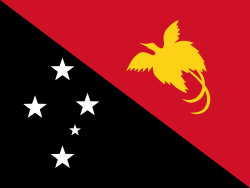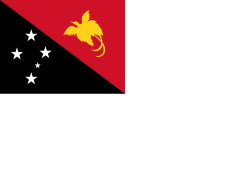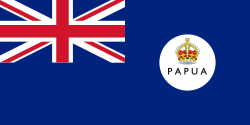- Flag of the governor-general of Papua New Guinea
 | |
| Use | National flag, civil and state ensign |
|---|---|
| Proportion | 3:4 |
| Adopted | 1 July 1971 |
| Design | Divided diagonally from the upper hoist-side corner to the lower fly-side corner: the upper triangle is red with the soaring Raggiana bird-of-paradise and the lower triangle is black with the Southern Cross of four white larger five-pointed stars and the smaller star. |
| Designed by | Susan Karike Huhume Hal Holman |
 | |
| Use | Naval ensign |
| Proportion | 3:4 |
| Design | A white flag with the national flag of Papua New Guinea in the canton |

The flag of Papua New Guinea [a] was adopted on 1 July 1971. In the hoist, it depicts the Southern Cross; in the fly, a Raggiana bird-of-paradise is silhouetted. [1]
Contents
- Design
- Specification
- Colours
- History
- Government flags
- Historical flags of Papua New Guinea
- See also
- Notes
- References
Red and black have long been traditional colours of many Papua New Guinean tribes. Black-white-red was the colour of the German Empire flag, which had colonised New Guinea prior to 1918. The bird-of-paradise is also found on the national coat-of-arms. The Southern Cross is a common symbol on the flags of countries in the Southern Hemisphere, where the constellation can be seen.
Prior to independence, the Australian administration proposed a vertical tricolour flag with blue, yellow and green bands, along with the bird-of-paradise and southern cross, designed by Hal Holman. [2] The blue was said to represent the sea and islands of New Guinea, the Southern Cross was a guide for the traveling peoples, the gold represented the coastlines, mineral wealth, and unity, and the green represented the forested highlands and mainland, with the Bird of Paradise representing the unification under one nation. [3] It had a mainly negative reception, due to its appearance as that of a "mechanically contrived outcome", thus after a nationwide design competition in early 1971, a winning redesign by 15-year old schoolgirl Susan Karike was chosen instead. [4]








